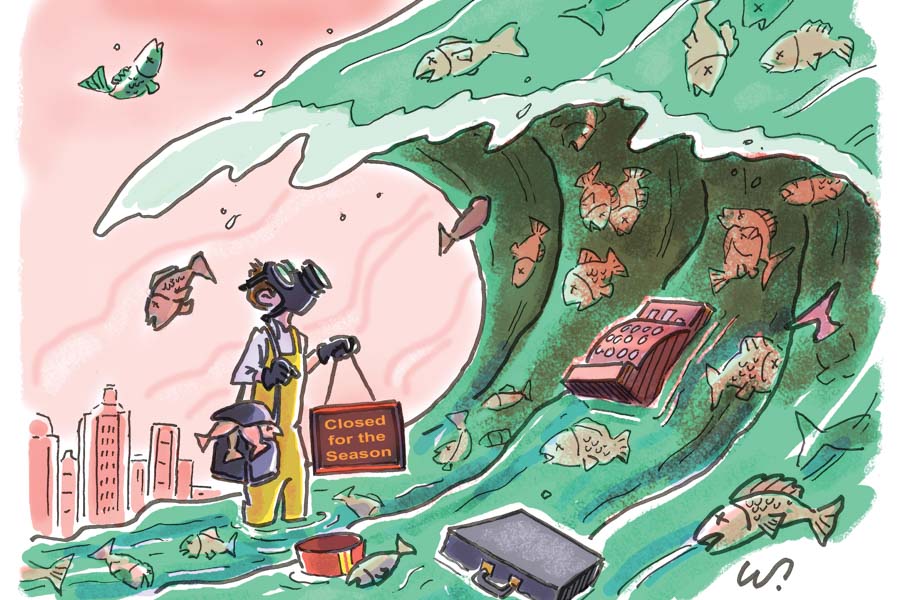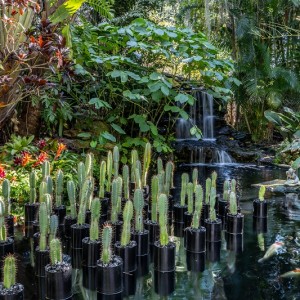To call it a summer in bloom would romanticize 2018 too much. In Florida’s southern and coastal communities, algae polluted the waterways and headlines for months, killing fish by the tons, poisoning dolphins and manatees, wrecking cash registers. It started for those along the Caloosahatchee and St. Lucie rivers when explosions of blue-green algae coated the tributaries with thick guacamole-like gunk. As exploding cells released putrid, poisonous toxins into the air, dead fished washed into docks and the air in waterways turned toxic, prompting a state of emergency in every county along each river. Then came red tide. The new algal attack spread along Florida’s Gulf coast, including Sarasota and Manatee counties, causing no-swim advisories and spreading anxieties about algae through the region. As news of the blooms reached international audiences, hotels reported cancelations and businesses relying on visitor traffic took a hit. “In terms of economic impact, its certainly the worst [red tide] we’ve ever seen,” says Virginia Haley, president of Visit Sarasota County. But what happens now and how can further algal blooms be stopped in the future?

ILLUSTRATION BY WOODY WOODMAN.
TALE OF ALGAES
The two-front algae problem attacking South Florida this year in fact involves two types of blooms, and the relationship between the phenomena isn’t as clear as one might suspect. Around Lake Okeechobee, communities were first stung by cyanobacteria, a type of bacteria that exists in high concentration in Florida’s largest lake. Named for its color, the algae burst in the adjacent Caloosahatchee and St. Lucie rivers after freshwater discharges—meant to prevent flooding in surrounding agricultural and residential communities—scheduled by the Army Corps of Engineers. Because of the heavy nutrient concentration in the water, which comes from a variety of sources including phosphate mining, sugar production, old agricultural sediment and septic tank use, the rivers get turned into an environment ripe for blooms. And for four consecutive years, blue-green algae became the predictable plague of communities between Lake O and the coasts.
Red tide, in contrast, blooms exclusively in saltwater environments. The colorful term references Karenia brevis, algae that can thrive with the right mix of dinoflagellates and sea water conditions. It’s this type of bloom that most directly impacted beach communities this year, with reports of harmful algae from Naples to St Petersburg.
The blooms occurred as freshwater discharges out of the Caloosahatchee River reached estuary waters. Engineers at AXI International, a Fort Myers company marketing algae solutions through its Project Blue initiative, says there’s a direct relationship to the blue-green algae impacting the rivers and the red tide now striking Florida’s west coast. In animations, engineers explain how nutrients released by the blue-green algae bursting ends up feeding the saltwater algae. The company proposes sonic buoys that stop the blue-green algae from reaching the surface of the rivers, and suggests that could curb red tide. But this isn’t a phenomenon marked by tremendous scientific consensus. Scientists at Mote Marine Laboratory say red tide blooms can’t so easily be connected to any single human-caused event. The harmful algal blooms constitute a natural disaster, according to marine scientists at the Sarasota institution.
“The biggest thing to pay attention to is that red tide blooms form offshore, 10-40 miles offshore. As they move onshore, blooms can utilize a variety of nutrient sources in coastal waters, including natural and human-contributed sources of nutrients,” says Mote public relations manager Stephannie Kettle. “Scientific data available so far suggest that it is possible for nutrients flowing from land to sea—including natural and human-contributed nutrients carried by stormwater runoff and riverine input—to serve as additional ‘food’ for growth of Karenia brevis red tide blooms that have moved to shore. However, the process is very complex. Karenia brevis can use at least 12 sources of nitrogen and phosphorous nutrients.”
That means all of the nutrient sources from man can contribute to blooms, but none gets identified as the chief culprit. Notably, the red tide blooms aren’t as predictable as the blue-green algae around Lake O. Before this year, the biggest red tide to hit Florida’s west coast came in 2006, years before the recent problems with discharges. The red tide blooms also don’t hit both coasts equally, despite discharges being released to the east and west; last year the east coast saw red tide but the west did not. But the Calusa Waterkeeper organization says frequency of red tides increased substantially in recent years. There were no major red ride blooms reported between 1953 and 1994, for example, but there’s been at least one near Florida’s coast somewhere at least once a year since 1998. As to the reason, that’s a great way to get finger-pointing to start.
BLAME GAME
Mary Rundeberg, a retired Michigan State University professor now living in Englewood, scoffs when people describe the natural causes for red tide. Yes, the algae normally lives 40 miles off the coast, but the red tide people care about is the stuff blooming close to shore. “I’m extremely disappointed in the institutions promoting this,” she says. “The bloom we’ve had here is unnatural.” She says the abundance of nutrient sources running off Florida’s shore into the water feeds the algae, and that serves as the reason for the explosive growth. It’s also the one source government can cut off to stop red tide before it explodes.
But government officials, while anxious to find a solution to the algal problems, remain reluctant to identify a particular source. While environmentalists in the region point toward certain industries contributing large amounts of phosphates into the water, there’s just as much science suggesting such pollution plays a small, even negligent, role in the algae problems faced by Florida this year.
Jackie Barron, public affairs manager for The Mosaic Company, hears criticism from self-described environmentalists attacking phosphate mining. “I’m also aware of well-respected environmentalists who do not point to phosphate as the cause of red tide, based on science not rhetoric,” she says.
Any water discharges directly from Mosaic get strictly reviewed for compliance under the federal Clean Water Act, she says. Those regulations don’t change year to year. She also notes that in the Tampa Bay watersheds near Mosaic facilities, officials witnessed a 3-percent increase in sea grass between 2014 and 2016, evidence there’s less nutrient-loading pollution going into the bay from the Mosaic sites. The more sound explanation for this year’s blooms, Barron says, comes from the skies above. “We saw a perfect storm of rainfall, wind and currents this year that have contributed to the current conditions,” she says. The heavy water contributes to greater currents to bring red tide near the shore, she says.
“Unfortunately, these are problems that will not easily be solved," Barron says. "But, as you are aware, the state has stepped up its funding to aid both the response from local governments as well as those research agencies working hard for answers." Mosaic cites Mote studies pointing to natural causes for red tide, which actually prompted some environmental activists this summer to note philanthropic support from Mosaic to the Sarasota lab. Mote officials in July released a statement clarifying Mosaic funding has never gone toward the study of red tide. And Mote officials note they don’t dismiss the role of pollution.
Dr. Richard Pierce, an eco-toxicologist and associate vice president for research at Mote, says a distinction must be drawn between the source of red tide and what makes it worse. “We have log reports from Spanish explorers from the 1500s about massive fish deaths,” he says. “We know it’s not anything people are doing today that causes red tide.”
But that doesn’t exonerate man. Look no further than the location of red tide blooms, which appear much worse along developed portions of Florida’s coast, to see that, Pierce says. The hundreds of thousands of homes and other facilities between Orlando and Lake Okeechobee certainly feed nutrients and pollution that goes into that water body to worsen blue-green algae. And stormwater runoff on shores up and down both coasts helps to feed red tide. “It all contributes,” he says, “and there has to be a collective effort to reduce the amount of nutrients.” Mote scientists have talked to farmers and agricultural landowners about ways to reduce runoff.
The most frequent subject of scorn, particularly regarding discharges from Lake Okeechobee, remains the sugar industry, the most active agriculture use still allowed around the body of water. Ironically, sugar acquired much of the land around the lake at a time the state sought cleaner agricultural users that would pollute less than livestock. Ecologist John Capece says that the remaining nutrient pollution from livestock not on the land since the ‘80s remains one of the worst sources of nutrients in Lake O, but sugar comes in behind that.
US Sugar representatives did not return calls from SRQ, but in 2014 issued a lengthy response to the magazine about a report then outlining concerns about pollution. Judy Clayton Sanchez, public affairs director for US Sugar, called suggestions sugar had anything to do with excess rainfall discharges from the Lake a “discredited idea.” “According to 20 years of data provided by the South Florida Water Management District, less than 5 percent of the water and the nutrients added to Lake Okeechobee come from the communities south of the lake,” she wrote. And any red tide blooms north of the rivers out of Lake O should not be attributed to the activity so far south. “Water rarely flows uphill,” she wrote.
That hasn’t stopped the formation of groups like BullSugar, which exists to provide a political counterpoint to contributions from US Sugar to politicians on both sides of the aisle. And whatever the cause of algal blooms, sugar companies have been extremely active in Florida politics for decades. Famously, sugar company Florida Crystals is owned by brother Alfy Fanjul and Pepe Fanjul, powerful donors in the Democratic and Republican party respectively.
The political villainizing that comes with that only increased the profile of the region’s troubles with algae this year. “There’s a lot of people trying politically to use red tide,” laments Haley. “Of note, let’s make it happen so this never happens again when we have a wide open election statewide in the governor and Senate race.”
Indeed, debates for governor this year for both parties included lengthy discussion about red tide and blue-green algae. As it happens, both parties nominated individuals—Democrat Andrew Gillum and Republican Ron DeSantis—who heavily criticized the sugar industry during the course of the campaign. Gillum in October held a press conference on Siesta Key with state Rep. Margaret Good, R-Sarasota, to discuss the need for stronger environmental oversight regarding red tide. And DeSantis in September delayed a weekend rally in Sarasota so he could meet with scientists at Florida Gulf Coast University to discuss solutions to stop the spread of blue-green algae, notably with a reservoir and more accountability for polluters around Lake Okeechobee.
AFTERMATH
In surveys conducted by Visit Sarasota County, Haley says the economic turmoil of red tide only grew as summer progressed. While the summer often marks a downtime for area hotels, the longer the crisis lingered, the more hotels and restaurants began reporting layoffs. As of the last week in August, Haley says 46 percent of hospitality companies reporting red tide impacts said they had seen business decrease by more then 50 percent, and another 35 percent of companies saw a decline of 25 percent of more.
Ann Frescura, executive director of the Siesta Key Chamber of Commerce, says foot traffic declined tremendously for beach communities this year and many renters report cancellations. “That affects all of our shops and bars,” she says. But Frescura says the region has continued to promote positive imagery of the beaches, with webcams showing live feeds so people around the world can see water conditions at any given moment. Haley says her organization publicizes when no-swim advisories get issued and lifted, and points tourists toward Mote reports on beach conditions each day. But those conditions literally change with the wind.
As for companies in need of economic assistance, small business owners affected by red tide in Sarasota and Manatee counties since August could qualify for bridge loans of up to $50,000 from the state, money that could mean the difference in keeping doors open at some establishments.
“In overcoming disaster events, each day that passes, the likelihood of businesses closing goes up and up,” says Michael Myhre, CEO of the Florida Small Business Development Center.
And beginning in November, the Small Business Administration says companies struck by red tide can apply for federal loans. "Sarasota County is committed to ensuring that all resources that are available to the business community are provided in a seamless and expedient fashion," said Sarasota County Governmental Relations Director Rob Lewis.
It’s important to note all of this assistance comes in the form of loans, not grants, so money will need to be repaid.
Political and industry leaders, meanwhile say they will continue to study and explore ways to prevent red tide from striking the region so hard in the future. U.S. Sens. Marco Rubio and Bill Nelson both have supported including funding for a second reservoir south of Lake Okeechobee to hold excess water instead of discharging it downstream, a measure supported by Gov. Rick Scott.
With Nelson and Scott engaged in a feisty U.S. Senate race right now—Scott in August won the Republican nomination to challenge Nelson’s re-election—the question of whether state or federal regulators showed more neglect in allowing the algal blooms becomes an election year issue debated statewide.
But local officials say the solutions ultimately must be found with a bipartisan commitment to study the facts. Good, a Democrat, this August held a town hall with Republican state Rep. Joe Gruters, a candidate for state Senate in District 23, and both promised to work together on finding answers. Gruters says lawmakers in Tallahassee have to look for ways to stop all levels of man-made pollution. “I’m all for making polluters pay,” he says, “but we are all part of a problem. The state may need to look at programs to get more homes off septic, to buy more land around Lake Okeechobee, and look at penalties on industry.” SRQ









